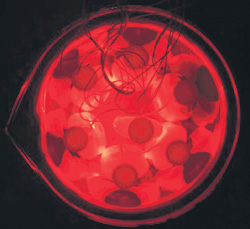
Breathing space for creativity”Degree Show” of the final year students of Visual Arts and Design, University of Kelaniya, held from April 24 to May 10 at the Barefoot Gallery, Colombo. Reviewed by Dr. Asoka de Zoysa. The exhibits at the “Degree show” at the Barefoot Gallery are the final products of a long winded process of research and experimenting to develop the idea. The works of art have not been created primarily for sale, but to be critiqued and evaluated under academic standards after four years of learning and experimenting. The themes chosen arise from issues that concern the group of young people coming mainly from a rural background. Based on their values, social and political consciousness, they are able to give expression to their personal experiences through paintings, installations and even video art. Seven female and three male undergraduates, set the stage for a discourse.
For the five paintings entitled “Western province”, Chandani Hatharasinghe uses maps of the Western province and Colombo, prime areas targeted by suicide bombers. Fragmented self-portraits appear enmeshed between the roads of the maps. They show her anxiety about living an uncertain life in times of war. The found-objects used instead of canvas for Duminda Subhashana’s paintings “My share of Tsunami” are doors of cars he found in the debris of the disaster. The expressive faces convey his message that “36,000 lives could have survived, if there was active management”. He himself survived. Used cooking pans and not canvas hold images of the ideal beauty dictated by fashion in Shrimani Kumari’s installation “Cooked fashion”. To the artist, fashion is dictated through media. The pans symbolize her discomfort due to restrictions imposed from the environment back at home. Within the traditional framework of oil on canvas, Nelika Lakmini presents her “Anti-art” called “Still life”. Due to the polluted environment she is unable to paint “still lives” as Van Gogh and Cezanne did, but paints the garbage that surrounds her. Her comment is on industrialization, urbanization, open economy and consumerism, which become a web in which she places her self-portrait. Chitrapali Champa Kumari’s painting “Rebuilding my body” shows her engagement with her own body. She comments “I had to think of my body many times. Who makes my body? What’s the shape of it?” Western designs dictate measurements of breast, hip and waist to suit fashions created for western women. The Asian women must “rebuild her body” to be able to follow these fashions. The artist shows herself in the ideal body shape posing like the westernized model seen in lifestyle magazines. She becomes the ideal silhouette, multiplied on the canvas in a grid like Andy Warhol’s soup tins. A complete departure from the standard modes of expression is seen in Mahesh Weerasinghe’s ‘Masochism’. It is his dialogue with pornography which is easily accessible through VCD, DVD and Internet today in Sri Lanka. Discarded Motherboards serve as his canvas to enclose the photographs and insects. The Internet will be reaching most remote corners of Sri Lanka, as a conscious effort to keep in pace with globalization. As such, the effects of uncontrolled consumption of pornography and violence through the Internet will have to be addressed in future. For the installation “The silent protest”, Madduma Patabandige Shyamali uses empty baby oil bottles, beakers, surgical wool, wire, thin tubes and buds of flowers, mixing real objects, symbols and use forms, colour, shapes and texture to tease out associations in the observer’s mind to make her very powerful statement about illegal abortions. Kaumudi Karunarathna’s “Fantasy friends” and Dhammika Sirimanne’s “Untitled” both are fascinating. A multitude of miniature figures are used in these two installations. Some as extra-terrestrials and some as fantasy animals born in the creative minds of these young artists, they show the artist’s craftsmanship to translate the imagination to tangible objects. In the same way, Krishantha Basnayake invites the visitor to his installation “Dream zone”. His own pillow is part of this voyage to the subconscious. When questioning western lifestyles and attitudes, the artists are not in any way taking refuge in the “anti-imperialistic” student rhetoric nor are they flaunting post modernistic buzz words to reach the “NGO set” in Colombo. The themes are interconnected and have cross-references to each other. With the “Degree Show” of 2008, the students have ventured to reach out to a new critical audience beyond the exhibition space within the university. The “Barefoot Gallery Colombo” is the ideal location for such an exhibition. A more tolerant space, I would say, than within the walls of one of the most conservative universities of Sri Lanka, where last year’s exhibition was held. Under the guidance of Kingsley Gunatilleke, himself one of the pioneers of “Conceptual art” in Sri Lanka, the undergraduates have been given the creative space to work without restrictions the academic institution usually poses. (The reviewer is attached to the Department of Modern Languages, University of Kelaniya) |
|
||||||
|| Front
Page | News | Editorial | Columns | Sports | Plus | Financial
Times | International | Mirror | TV
Times | Funday
Times || |
| |
Reproduction of articles permitted when used without any alterations to contents and a link to the source page.
|
© Copyright
2008 | Wijeya
Newspapers Ltd.Colombo. Sri Lanka. All Rights Reserved. |
